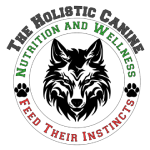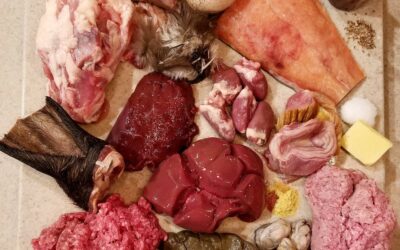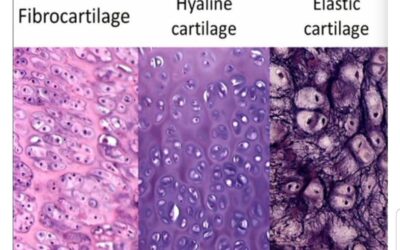PART 1
Most raw feeders who have educated themselves prior to beginning a raw nutrition plan know that certain nutrients tend to lack in a homemade raw diet. Vitamins D and E, two vital fat-soluble nutrients, top the list for nutrient-deficient vitamins. For minerals, the top most deficient is manganese, a trace mineral most people have either never heard of or mistake for magnesium, the macro-mineral. Following manganese are the trace minerals copper, iron, and zinc and the macro minerals magnesium and potassium. With a properly balanced diet, all of these nutrients can be fulfilled.
Vitamins D & E are fat-soluble vitamins requiring fat for absorption. Unlike water-soluble nutrients, these nutrients are stored in the body. Vitamin D is stored in the liver and fat tissues to be drawn upon when needed. Food sources of Vitamin D are almost never toxic; however, excessive supplemental Vitamin D can be, such as what is added to commercial dog foods. Although Vitamin D toxicity is rare, I still recommend supplemental D be used with caution if you are unable to provide adequate food-sourced Vitamin D through the diet.
Vitamin E is also stored in the fat tissues of the body. Despite being fat-soluble, I recommend that this vitamin be supplied daily. Vitamin E toxicity is an extremely difficult occurrence and near impossible through food sources. Vitamin E functions primarily as an antioxidant and prevents cellular damage from oxidized fat. This vitamin functions similar to the mineral selenium. An abundance of selenium in the diet will reduce the amount of Vitamin E required. Because animal food sources do not supply adequate Vitamin E, alternative plant sources must be fed.
If you must supplement either or both of these vitamins, understand that science has shown that synthetic and nutrient isolates do not and cannot perform nor function in the same manner as naturally occurring food nutrients. Do not purchase a synthetic version of either of these vitamins, and do not be misled by the “natural” Vitamin E isolate d-alpha tocopherol. Vitamin E is a complex and needs to be consumed as a complex for optimal absorption and utilization. The synthetic, isolate, and non-bioavailable forms to avoid are:
- Ergocalciferol (Synthetic Vitamin D)
- Calciferol D2
- dl-alpha tocopherol (Synthetic Vitamin E)
- d-alpha tocopherol (Isolated alpha)
To supplement Vitamins D and E, use either a whole food source or a natural vitamin supplement such as:
- Cholecalciferol (vitamin D3)
- Mixed tocopherols (vitamin E complex)
I do NOT recommend cod liver oil for a Vitamin D supplement as this also contains Vitamin A. If you feed liver, this is a huge NO. This can cause hypervitaminosis A, a very serious vitamin A toxicity condition.
Wild dogs receive Vitamin D from the skin, organs, fat, and bone marrow of their prey. Vitamin E is needed in small amounts in the presence of selenium which wild dogs receive in plenty from flesh, organs, and bone.
Vitamin D: highest food sources
- Mackerel (547 IU [13.7 mcg] in 3 oz.)
- Salmon (425 IU [10.6 mcg] in 3 oz.)
- Canned Sardines (270 IU [6.75 mcg] per can)
- Beef/Calf liver (42 IU [1 mcg]) in 3 oz.)
- Egg yolk (41 IU [1 mcg] per egg)
- Plain yogurt (90 IU [2.25 mcg] in 6 oz.)
Supplemental D: Cholecalciferol (D3) only Dose*: 100-200 IU (2.5-5 mcg) for medium dog
*Because Vitamin D is stored in the body, I recommend these LOW doses especially when used in combination with Vitamin D rich foods. A low dose can be given daily.
Vitamin E: highest food sources
- Wheat germ oil (20 mg in 1 tbsp.)
- Sunflower seeds (10 mg in 1 oz.)
- Pumpkin seeds (10 mg in 1 oz.)
- Hemp seed oil (10 mg in 1 tbsp.)
- Almonds (7.4 mg in 1 oz.)
- Avocado (2.1 mg in half the fruit)
Supplemental E: Use mixed tocopherols ONLY Dose: 10-15 mg for medium dog
The trace minerals manganese, copper, iron, and zinc are not difficult to source if raw-feeding pet parents know how to source foods that contain these vital nutrients. Some simple adjustments or food additions is often all that is needed.
Manganese is the most difficult trace mineral to source. Wild dogs receive this nutrient from red fur and feathers, bone marrow, and blood. Pet parents do not always have access to whole prey, and some dogs want nothing to do with a whole animal plopped down for dinner. We often need to be creative to find alternative sources. Green lipped mussels and plants, however, provide adequate amounts and bioavailable (useable) forms of manganese.
Manganese: highest food sources
- Green lipped mussels (5.8 mg in 3 oz.)
- Turmeric (5.6 mg in 1 oz.)
- Hemp seeds (2.2 mg in 1 oz.)
- Pumpkin seeds (1.29 mg in 1 oz.)
- Ginger, ground (0.58 mg in 1 tsp)
- Raspberries & Blackberries (0.38 mg in 2 oz.)
- Almonds (0.65 mg in 1 oz.)
Copper, iron, and zinc are not difficult to source if you choose your foods wisely. The problem stems from many pet parents relying heavily upon chicken and chicken liver for the majority of their meals. This is due to cost efficiency and ease of supplying RMBs. By adding alternative food options, these minerals can be easily fulfilled.
Copper: highest food sources
- Beef/Calf liver (4 mg in 1 oz.)*
- Oysters (2.5 mg in 2 oz. canned)
*This one simple switch fulfills copper requirements!
Wild dogs receive their iron needs from blood, bone marrow, and organs.
Iron: highest food sources
- Chicken hearts (5.96 mg in 3.5 oz.)
- Beef heart (4.3 mg in 3.5 oz.)
- Sardines (2.92 mg per can)
- Goat (2.8 mg in 3.5 oz.)
- Chicken liver (2.6 mg in 1 oz.)
- Chicken gizzards (2.49 mg in 3.5 oz.)
- Beef (2 mg in 3.5 oz.)
- Rabbit (1.57 mg in 3.5 oz.)
- Beef liver (1.4 mg in 1 oz.)
- Beef kidney (1.3 mg in 1 oz.)
- Egg, whole (0.6 mg in 1 egg)
Wild dogs receive zinc from bones, blood, flesh, skin, and organs.
Zinc: highest food sources
- Oysters (51.57 mg in 2 oz. canned)*
- Chicken hearts (7 mg in 3.5oz.)
- Beef (4.55 mg in 3.5 oz.)
- Chicken gizzards (4.3 mg in 3.5 oz.)
*This one simple addition fulfills zinc requirements!
When it comes to supplementing these three trace minerals, knowledge is essential or a variety of imbalances, deficiencies, and injury can occur. To begin, these three nutrients are antagonistic with each other and must be supplemented together. I never advise anyone to supplement with either zinc or copper. Although you can squeeze by with manganese as an individual addition to meals, my best professional opinion is to provide all three in the appropriate ratios. Supplementation is a whole different ball game compared with providing food-sourced organic minerals. Thus, there is another important factor that must be understood. Because this applies to all minerals, I will discuss supplementing at the end. Let’s first look at magnesium and potassium.
A seemingly difficult-to-source macro mineral is magnesium. This is because animal flesh and organs are very low in this essential mineral. Nevertheless, magnesium deficiency is extremely rare in dogs. Where it does occur, it is a condition in dogs fed low quality commercial kibbles and those who are badly malnourished. As of a recent data base search, there exists no recorded case of a magnesium-deficient raw fed dog who received bones. This is likely because bones provide magnesium, the most overlooked food source of this mineral, numerous other minerals, and fat-soluble vitamins. Because people do not consume bones, adequate and reliable nutrient profiles have not been determined on bone. As a result, many raw feeders relying upon nutritional data apps have a difficult time providing food sources of magnesium, and therefore, turn to inappropriate food sources such as oatmeal to “hypothetically” fulfill magnesium requirements. As long as you are feeding bones along with the following species-appropriate foods, magnesium requirements will be adequately met.
Magnesium: highest food sources
- Spinach, cooked (157 mg in 1 c.)
- Swiss chard, cooked (150 mg in 1 c.)
- Pumpkin seeds (92 mg in 1/8 c.)
- Avocado (58 mg in 1 med.)
- Salmon (53 mg in 3.5 oz.)
- Mackerel (40 mg. in 3.5 oz.)
- Oysters (30.6 mg in 2 oz. canned)
- Banana (30 mg in 1 med.)
- Spinach, raw (24 mg in 1 c.)
- Yogurt, low-fat (23.5 mg in ½ c.)
Surprisingly, potassium often comes up low on analyzed raw food recipes. This macro mineral has the body’s highest mineral requirement along with calcium and phosphorus. Most foods contain potassium, but because the need is so high, it can be a daunting task trying to provide adequate amounts. Nearly all meat, fish, and organs provide approximately 300-550 mg in every 3.5 ounces. Bone also provides potassium, however, the value (amount) is not known. The raw meals that come in with the highest potassium levels are those that include plants as “extras.”
Potassium: highest food sources
- Beet greens, cooked (1309 mg in 1 c.)
- Avocado (975 mg in 1 med.)
- Swiss chard, cooked (961mg in 1 c.)
- Spinach, cooked (839 mg in 1 c.)
- Sweet Potato, cooked (536 mg in 1 c.)
- Zucchini, raw (459 mg in 3.5 oz.)
Exact nutrient profiles for bone have not been completed; however, bone does provide:
Bone tissue:
Calcium Phosphorus
Magnesium Sodium
Potassium Chloride
Sulfur Silica
Marrow:
Vitamin A Vitamin K
Iron Zinc
Selenium Manganese
Boron Omega-3 fatty acids
Minerals and Mineral Supplementation: Natural minerals are inorganic compounds (rock) that are found in the earth. Animals (and humans) cannot synthesize minerals, nor can they directly utilize mineral salts from the earth or the sea. Rather, earth and sea mineral salts are absorbed by the roots of plants and following various metabolic processes, the absorbed minerals become complexed with carbohydrates, fats, and proteins within the plants. In other words, plants absorb the inorganic mineral salts and convert them into organic nutrients that humans and animals require. The only way that our pets and people can receive bioavailable (absorbable and useable) minerals is through the consumption of plants and the animals that ate the plants. Let me recap this again. Inorganic minerals are plant food. Organic minerals are food for people and animals. People and animals CANNOT utilize plant food. And yet, many mineral supplements are inorganic. It is these mineral supplements that cause an array of complications, including death.
Sadly, our soils are becoming increasingly more depleted of minerals. We are on the verge of a crisis. Organic farming practices are essential for increasing and maintaining soil-mineral levels in order that we and our pets do not become mineral deficient. When it comes to the raw diets we create and provide for our pets, there is a concern that I want to make pet parents aware of. The universal nutrient profiles that many pet parents are relying upon via nutrition apps and raw food calculators are mere “hypothetical” values based on averages and potentials which are then pooled into a data base. In reality, nutrient profiles and values vary immensely among the same food items being wholly dependent upon soil conditions, whether organically grown or raised, or conventionally grown or farmed, the weather throughout the growing season, environmental factors, the country or sea of origin, whether wild-caught or farmed, the diet feed-animals consumed, when and how the food is harvested, when and how an animal is slaughtered, preparation for packaging or shipment, the actual shipment process, travel-time, handling by grocers and market employees, and on and on. Even without knowing it, we are many times providing our pets with nutrient-deficient meals via our choice of ingredients. While nutrition apps and dog food designer programs are helpful, they are not based on reality. However, they are not completely useless albeit they are not accurate to give you a guaranteed nutrient profile for the foods in your pet’s bowl. Chosen food sources may be, and often are, deficient especially if the foods purchased are the cheapest cost available, especially from discount grocery stores and markets. Worse, pet parents who fall under the false notion that dogs should not or do not need plants in their daily meals are at the greatest risk for coming up short on numerous nutrient needs. To have a near guaranteed nutrient profile, purchase foods from farms that have their nutrient values analyzed for all the products they raise, grow, and sell. Since there exists very few farms that do just this, source the highest quality foods you are able to afford; foods that are naturally, organically, and/or ethically raised along with non-GMO, organically grown plant and supplemental “superfood” ingredients.
Keeping all this in mind, if you are unfamiliar with the potential nutrients found in common raw food ingredients, and especially, if you are sourcing cheap, lower quality ingredients, I recommend using a spreadsheet calculator or meal designer program that can analyze your dog’s meals. Calculators are available for free on many raw food websites. The Holistic Canine has calculators available in the Facebook group files section. Here is the best way to use the calculators and programs:
1) If you are purchasing the lowest quality ingredients, consider the nutrient values in your chosen ingredients slightly less than the program’s stored nutritional profiles. Most calculators have both AAFCO’s and the NRC’s minimum nutrient requirements. Use the NRC’s nutrient minimums and raise them 10%. Evaluate your meals and supplement where you are consistently hitting minimums or coming up short.
2) If you are using the highest quality ingredients, your nutrients are likely close to ideal. If an analysis program shows your ingredients are hitting minimums, add simple whole food supplement powders such as spirulina, wheatgrass, chlorella, alfalfa, kelp, and green lipped mussels and your levels will reach optimal. If the farm has provided a nutrient analysis on your purchased foods, use those values rather than the values in your app, calculator, or diet designer program. This may require paper, pen, and some math! Pay the closet attention to the nutrients that are often minimum or deficient. If a mineral or minerals is/are consistently low, you need to supplement.
Mineral supplements come in two types: 1) Inorganic– rock minerals known as mineral salts chelated (bound) to an acid or another mineral, and 2) Organic– mineral salts chelated to a nutrient such as an amino acid and a peptide. Inorganic supplements are strongly cautioned against. They can be dangerous as the body does not utilize the minerals correctly often causing minerals to be displaced as seen in the example of calcium supplementation causing heart attacks and death in women. You will want to avoid inorganic supplements such as these popular industrial chemical examples:
- Calcium carbonate, -citrate, -gluconate, -lactate, and -phosphate
- Copper carbonate, -gluconate
- Magnesium carbonate, -chloride, -citrate
- Potassium chloride, -iodide, -sulfate
- Zinc carbonate, -chloride, -citrate, -gluconate, -oxide, -picolinate, -sulfate
Ideally, you will want to purchase mineral supplements that are whole food sources, and if you cannot find or afford a whole food source, purchase organic* mineral chelates that are bound to a peptide and/or amino acid. Some examples of bioavailable supplements include:
- Eggshell or bone meal for calcium
- “Raw Organic* Whole Food” [mineral name] Ex: Raw Organic Whole Food Zinc
- “Raw” [mineral name] Ex.: Raw Zinc
- “Whole Food” [mineral name] Ex.: Whole Food Magnesium
- [Mineral name] “Food Complex” Ex.: Zinc Food Complex
- [Mineral name] “amino acid chelate” Ex.: Copper “amino acid chelate”
- Magnesium L-Threonate
- Zinc Biglycinate, L-Methionine, L-OptiZinc®
- Any mineral with the Albion® and TRAACS® labels
*Keep in mind, organic means the mineral is not a salt or chemical, but bound to a nutrient making it bioavailable to people and animals
To supplement zinc, copper, and manganese, you can choose supplements that are whole food sources which will require that each mineral be purchased individually. This can be very expensive. Or, purchase organic amino acid chelate minerals.
1) Whole food sourced mineral supplements should have a ratio of approximately 15mg: 1mg (zinc to copper) with 2-5mg manganese. Whole food sourced minerals do not need to be an exact ratio, but it is recommended to stay near to the recommendation. This dose is perfect for dog’s receiving dietary zinc and copper that are coming in low, but not deficient along with a deficient manganese level (most common scenario). If dietary manganese is low, but not deficient, keep the manganese dose to 2mg. Increase or decrease the doses in this ratio dependent upon your dog’s nutrient requirements. This dose is adequate for a medium dog.
2) If using organic chelate minerals, supplementing in the correct ratio is necessary. Do not stray too far from these recommendations or imbalance may occur. I highly recommend purchasing a zinc and copper combination in a ratio of 15:1 or 30:2 (zinc to copper). Determine your dog’s nutrient requirements for zinc, copper, and manganese. I purchase a zinc, copper, and kelp combination containing a dose of 15 mg zinc amino chelate, 1 mg copper amino chelate, and 53 mcg of iodine from kelp (a whole food source). Purchase a manganese Albion® product in the lowest dose possible. I found a 10 mg dose in capsules. Choose capsules for their ease of opening for partial dosing and closing it back up for later meals. In a meal where you require extra zinc and/or copper, supplement with the zinc/copper combination, and if your manganese levels are just at or slightly below, add manganese as well. For example, if I add one capsule of 15 mg zinc and 1 mg copper, I will add ¼ to ½ a capsule of a 10 mg dose of manganese which will yield approximately 2.5 mg to 5 mg. (It doesn’t have to be exactly ¼ or ½ the capsule. It will balance out when the entire capsule has been used.) This dose is sufficient for a dog that is 25 – 50 pounds. This will be an appropriate balance that will not cause an imbalance with any of these three minerals. Because supplements are treated differently within the body, I strongly recommend adding all three together.
Purchasing green lipped mussels (such as Thrive brand) provides all three of these minerals; however, the nutrient amounts are quite low and expressed in mcg. Wheatgrass is another source of these minerals; however, the nutrient levels vary widely from product to product. Unless the company has the nutrient profiles clearly analyzed by an outside lab and labeled as a guaranteed analysis, I would use it as superfood ingredient added to every meal in addition to the organic mineral supplements that are lacking. If you are inclined to sprout and grow your own wheatgrass, understand that hydroponic (water) sprouting and growing does NOT provide minerals such as soil provides. Your mineral values will be far too low to meet your dog’s mineral requirements. Even in 3.5 oz. of home-sprouted wheatgrass, you will barely meet the manganese need for a medium dog. Zinc and copper are so low they are reflected in mcg.
The average medium adult dog requires these nutrient minimums daily:
- Vitamin D: 4.3 mcg up to 20 mcg
- Vitamin E: 10 mg
- Manganese: 1.5 mg
- Copper: 2 mg
- Iron: 10 mg
- Zinc: 20 mg
- Magnesium: 190 mg
- Potassium: 1,400 mg (1.4 g)
©2018 Kimberly Lloyd, PhD, BCHHP, Cert Raw Dog Nutritionist



